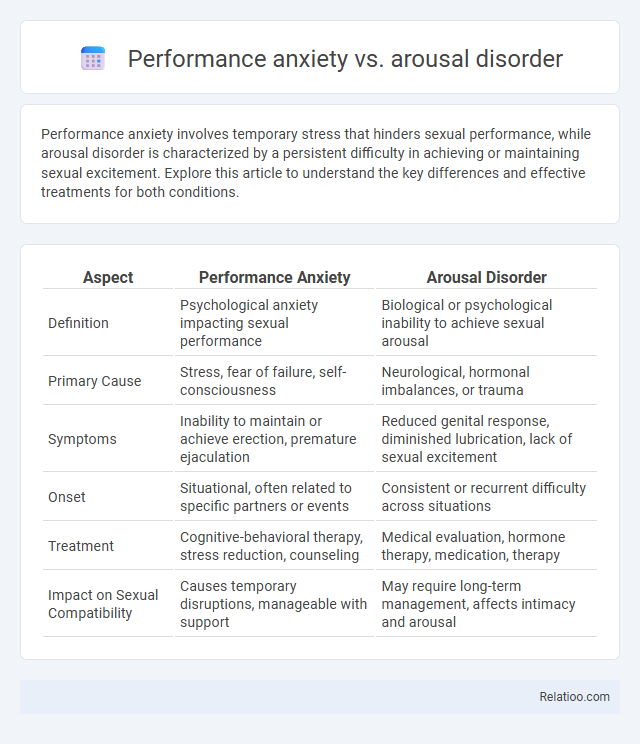Performance anxiety involves temporary stress that hinders sexual performance, while arousal disorder is characterized by a persistent difficulty in achieving or maintaining sexual excitement. Explore this article to understand the key differences and effective treatments for both conditions.
Table of Comparison
| Aspect | Performance Anxiety | Arousal Disorder |
|---|---|---|
| Definition | Psychological anxiety impacting sexual performance | Biological or psychological inability to achieve sexual arousal |
| Primary Cause | Stress, fear of failure, self-consciousness | Neurological, hormonal imbalances, or trauma |
| Symptoms | Inability to maintain or achieve erection, premature ejaculation | Reduced genital response, diminished lubrication, lack of sexual excitement |
| Onset | Situational, often related to specific partners or events | Consistent or recurrent difficulty across situations |
| Treatment | Cognitive-behavioral therapy, stress reduction, counseling | Medical evaluation, hormone therapy, medication, therapy |
| Impact on Sexual Compatibility | Causes temporary disruptions, manageable with support | May require long-term management, affects intimacy and arousal |
Understanding Performance Anxiety: Definition and Symptoms
Performance anxiety is a psychological condition characterized by intense fear or nervousness before or during performance situations, impacting individuals in domains such as public speaking, sports, or sexual activity. Symptoms include rapid heartbeat, sweating, trembling, dry mouth, and cognitive impairments like negative self-talk or difficulty concentrating. Unlike arousal disorder, which involves physiological challenges in sexual response, performance anxiety primarily stems from psychological stress and fear of failure or judgment.
What Is Arousal Disorder? Key Features Explained
Arousal disorder is a type of sexual dysfunction characterized by the inability to achieve or maintain sufficient physiological excitement during sexual activity, despite having sexual desire and stimulation. Key features include persistent or recurrent difficulty with genital lubrication or erection, often accompanied by minimal physical responses to sexual stimuli. Your experience of arousal disorder differs from performance anxiety, which stems from psychological stress or fear of sexual failure rather than physiological dysfunction.
Causes of Performance Anxiety in Intimate Settings
Performance anxiety in intimate settings primarily stems from fear of judgment, low self-esteem, and past negative experiences, which can trigger a stress response affecting sexual performance. Arousal disorder differs as it involves physiological difficulties in achieving or maintaining sexual excitement, often linked to hormonal imbalances or medical conditions rather than psychological factors. Understanding your specific causes, such as relationship issues or performance pressure, is crucial for addressing performance anxiety effectively.
Biological and Psychological Roots of Arousal Disorders
Performance anxiety primarily stems from psychological factors such as fear of judgment and negative self-evaluation, leading to stress-induced impairment in sexual or task performance. Arousal disorders, in contrast, often have biological roots including hormonal imbalances, neurological dysfunctions, or vascular issues that disrupt normal physiological arousal mechanisms. While performance anxiety is mostly driven by cognitive and emotional responses, arousal disorders require a multifaceted approach addressing both biological impairments and psychological influences to effectively restore normal function.
Performance Anxiety vs. Arousal Disorder: Key Differences
Performance anxiety primarily involves intense fear or worry about performing well in specific situations, often leading to avoidance and stress that impacts your ability to engage confidently. In contrast, arousal disorder is a physiological condition characterized by consistent difficulties in sexual arousal despite adequate desire, often unrelated to psychological stress. Understanding these distinctions helps target effective treatments, with performance anxiety focusing on cognitive-behavioral strategies and arousal disorder requiring medical or hormonal interventions.
Common Misconceptions and Myths
Performance anxiety, often confused with arousal disorder, is primarily a psychological condition causing fear and stress before or during sexual activity, whereas arousal disorder involves a physiological inability to attain or maintain sexual excitement. Common misconceptions wrongly assume that performance anxiety always stems from lack of attraction or relationship problems, ignoring its roots in mental health and stress factors. Your understanding improves when you recognize that these conditions require distinct approaches, debunking myths that they are interchangeable or simply caused by personal inadequacy.
Impact on Relationships and Emotional Well-being
Performance anxiety primarily causes stress and self-doubt, often leading to decreased intimacy and communication problems in relationships, negatively affecting emotional well-being. Arousal disorder, characterized by a persistent inability to achieve sexual arousal, can result in frustration, decreased relationship satisfaction, and increased emotional distress for both partners. Performance anxiety combined with arousal disorders intensifies relational strain and emotional instability, requiring targeted therapeutic interventions to restore healthy intimacy and psychological balance.
Diagnosis: How Professionals Distinguish Between the Two
Performance anxiety and arousal disorder both impact sexual function but are distinguished by clinical diagnosis emphasizing psychological versus physiological origins. Professionals diagnose performance anxiety through patient history revealing stress or fear-related symptoms without underlying physical causes, whereas arousal disorder involves measurable hormonal, neurological, or vascular abnormalities detected via medical tests. Your accurate diagnosis depends on comprehensive evaluation combining psychological assessment and medical examination to tailor effective treatment.
Effective Treatment Approaches for Each Condition
Performance anxiety requires cognitive-behavioral therapy (CBT) to address stressful thought patterns impacting your confidence, while arousal disorder often benefits from a combination of medical treatments and sex therapy targeting physiological and psychological factors. Performance anxiety treatment emphasizes relaxation techniques, mindfulness, and gradual exposure to performance situations, whereas arousal disorder may necessitate hormone evaluation or pharmacological intervention to restore normal sexual function. Tailoring therapy to the specific diagnostic profile ensures the most effective outcomes for each condition, improving both emotional well-being and sexual health.
Prevention and Self-Help Strategies
Performance anxiety and arousal disorder differ primarily in psychological versus physiological origins, requiring tailored prevention and self-help strategies. Prevention for performance anxiety focuses on cognitive-behavioral techniques, relaxation exercises, and mindfulness to reduce stress and negative thought patterns. Arousal disorder management emphasizes pelvic floor exercises, lifestyle modifications, and medical consultation alongside psychological support to enhance physiological response and sexual function.

Infographic: Performance anxiety vs arousal disorder
 relatioo.com
relatioo.com